#Real-World Applications using Data Science
Explore tagged Tumblr posts
Text
Data Science Transforming Urban Mobility and Smart Cities
Data science is an interdisciplinary field that utilises scientific methods, algorithms, and systems to extract insights and knowledge from structured and unstructured data. It combines various disciplines, such as statistics, computer science, and domain expertise, to uncover patterns, trends, and correlations that help organisations make informed decisions. In modern urban planning, data…

View On WordPress
0 notes
Text
The Four Horsemen of the Digital Apocalypse
Blockchain. Artificial Intelligence. Internet of Things. Big Data.
Do these terms sound familiar? You have probably been hearing some or all of them non stop for years. "They are the future. You don't want to be left behind, do you?"
While these topics, particularly crypto and AI, have been the subject of tech hype bubbles and inescapable on social media, there is actually something deeper and weirder going on if you scratch below the surface.
I am getting ready to apply for my PhD in financial technology, and in the academic business studies literature (Which is barely a science, but sometimes in academia you need to wade into the trash can.) any discussion of digital transformation or the process by which companies adopt IT seem to have a very specific idea about the future of technology, and it's always the same list, that list being, blockchain, AI, IoT, and Big Data. Sometimes the list changes with additions and substitutions, like the metaverse, advanced robotics, or gene editing, but there is this pervasive idea that the future of technology is fixed, and the list includes tech that goes from questionable to outright fraudulent, so where is this pervasive idea in the academic literature that has been bleeding into the wider culture coming from? What the hell is going on?
The answer is, it all comes from one guy. That guy is Klaus Schwab, the head of the World Economic Forum. Now there are a lot of conspiracies about the WEF and I don't really care about them, but the basic facts are it is a think tank that lobbies for sustainable capitalist agendas, and they famously hold a meeting every year where billionaires get together and talk about how bad they feel that they are destroying the planet and promise to do better. I am not here to pass judgement on the WEF. I don't buy into any of the conspiracies, there are plenty of real reasons to criticize them, and I am not going into that.
Basically, Schwab wrote a book titled the Fourth Industrial Revolution. In his model, the first three so-called industrial revolutions are:
1. The industrial revolution we all know about. Factories and mass production basically didn't exist before this. Using steam and water power allowed the transition from hand production to mass production, and accelerated the shift towards capitalism.
2. Electrification, allowing for light and machines for more efficient production lines. Phones for instant long distance communication. It allowed for much faster transfer of information and speed of production in factories.
3. Computing. The Space Age. Computing was introduced for industrial applications in the 50s, meaning previously problems that needed a specific machine engineered to solve them could now be solved in software by writing code, and certain problems would have been too big to solve without computing. Legend has it, Turing convinced the UK government to fund the building of the first computer by promising it could run chemical simulations to improve plastic production. Later, the introduction of home computing and the internet drastically affecting people's lives and their ability to access information.
That's fine, I will give him that. To me, they all represent changes in the means of production and the flow of information, but the Fourth Industrial revolution, Schwab argues, is how the technology of the 21st century is going to revolutionize business and capitalism, the way the first three did before. The technology in question being AI, Blockchain, IoT, and Big Data analytics. Buzzword, Buzzword, Buzzword.
The kicker though? Schwab based the Fourth Industrial revolution on a series of meetings he had, and did not construct it with any academic rigor or evidence. The meetings were with "numerous conversations I have had with business, government and civil society leaders, as well as technology pioneers and young people." (P.10 of the book) Despite apparently having two phds so presumably being capable of research, it seems like he just had a bunch of meetings where the techbros of the mid 2010s fed him a bunch of buzzwords, and got overly excited and wrote a book about it. And now, a generation of academics and researchers have uncritically taken that book as read, filled the business studies academic literature with the idea that these technologies are inevitably the future, and now that is permeating into the wider business ecosystem.
There are plenty of criticisms out there about the fourth industrial revolution as an idea, but I will just give the simplest one that I thought immediately as soon as I heard about the idea. How are any of the technologies listed in the fourth industrial revolution categorically different from computing? Are they actually changing the means of production and flow of information to a comparable degree to the previous revolutions, to such an extent as to be considered a new revolution entirely? The previous so called industrial revolutions were all huge paradigm shifts, and I do not see how a few new weird, questionable, and unreliable applications of computing count as a new paradigm shift.
What benefits will these new technologies actually bring? Who will they benefit? Do the researchers know? Does Schwab know? Does anyone know? I certainly don't, and despite reading a bunch of papers that are treating it as the inevitable future, I have not seen them offering any explanation.
There are plenty of other criticisms, and I found a nice summary from ICT Works here, it is a revolutionary view of history, an elite view of history, is based in great man theory, and most importantly, the fourth industrial revolution is a self fulfilling prophecy. One rich asshole wrote a book about some tech he got excited about, and now a generation are trying to build the world around it. The future is not fixed, we do not need to accept these technologies, and I have to believe a better technological world is possible instead of this capitalist infinite growth tech economy as big tech reckons with its midlife crisis, and how to make the internet sustainable as Apple, Google, Microsoft, Amazon, and Facebook, the most monopolistic and despotic tech companies in the world, are running out of new innovations and new markets to monopolize. The reason the big five are jumping on the fourth industrial revolution buzzwords as hard as they are is because they have run out of real, tangible innovations, and therefore run out of potential to grow.
#ai#artificial intelligence#blockchain#cryptocurrency#fourth industrial revolution#tech#technology#enshittification#anti ai#ai bullshit#world economic forum
32 notes
·
View notes
Text
Planet Naming Conventions In The Star Trek Universe (How To)



"THIS IS CETI ALPHA V!!! Ceti Alpha VI exploded six months after we were left here."
Khan Noonien Singh (played by Ricardo Montalban (1920 - 2009)) in Star Trek II, The Wrath Of Khan
While I was doing my usual scrolling routine in social media oulets like Facebook, I have found an interesting post in one of the FB pages related to Star Trek.
In the FB page, the administrator narrated in a post an experience of listening to a podcaster and a youtuber complaining about the name of certain planets in the Star Trek universe.
In particular, the format of a name followed by a roman number. Just like Ceti Alpha V and Ceti Alpha VI.
Indeed, this is a common practice of the franchise since its failed pilot episode, The Cage (presented in season one episodes The Menagerie, parts I and II). On it the crew of the USS Enterprise decided to explore a planet named Talos IV after received a distress signal from it.
More than common, it seems to be a standard practice for most of the planets.
It made me curious about finding the official rules of the franchise, if such as those rules exist.
My search for data at Memory Alpha was fruitless. But making a search by browsing about the subject led me to two links with a lot of interesting information at forums of Stack Exchange and Reddit.
From the discussions of some users and the explanation of the FB page administrator, I have to assume this is the rule of thumb for planet naming in the Star Trek universe.
Star Trek's planets naming conventions
According to the United Federation of Planets:
When a new group of planets were discovered, they are given the name of the star they orbit followed by a roman number in ascending order from the planet closest to the star to the farthest.
As an example of this, let's take the star and planets of our Solar System. The star name is Sol, hence Earth have to be Sol III and Mars have to be Sol IV.
In addition, when the race of a given planet made the first contact, the Federation will recognize the names the race gave to their system's planets.
As an example, there are planets like Earth, Vulcan, Romulus and Andoria.
A real-world example
Here on planet Earth, organizations as the International Astronimical Union are in charge of putting names to planets or other kind of celestial bodies.
Let's take for example an exoplanet (planet outside of our solar system), HD 189733 b.

Let's take for example an exoplanet (planet outside of our solar system), HD 189733 b.
The 'HD' part of the name means for the person or research group who found it. In this case, it stands for the Henry Draper Catalogue. The numerical string '189743' stands for the number in the catalog in the order it was found.
The lower case 'b' part respond to the order of its position in the star system. It represents it is the planet closest to the orbit of the star. Other planets of this system must use the lower case letters 'c', 'd', 'e' or 'f' in order of the closest to the farthest they are in orbit of the star.
The upper case letter 'A' is used exclusively for the identifiying the star. Also upper case letters 'B' and 'C' are used only to identify stars in case it is binary or trinary star systems.
An application of what I learned
To illustrate what I learned about the naming convention used by the franchise of Star Trek, I created a star system and for its name, I named the system's star with the name of Cressidia. A very beautiful name it came to my mind.

As you can see, I named Cressidia I to the planet closest to the star and left roman numbers II to VI to the second to the sixth planets of the system respectively.
Food for thought
Names for star can be inspired in every single kind of mythology or influential culture of the World.
If you are a soft science fiction or fantasy writer, you can name stars as you wish, just in case your work does not need for any kind of scientific accuracy.
In case you have to write for an established sci-fi franchise, you better have to made research of its naming conventions.
The Star Trek and Star Wars universes have a lot of resources like star maps you have to read before starting to work on your story.
There is a fantastic material to read more about star names. You can learn about the meaning of star names by reading the book, Star-Names and Their Meanings by Richard Hinckley Allen.
It was published in 1899, making it hard to find in the printed format, but thanks to the people of the Internet Archive, it is available in many different kinds of ebook.
The link to get it for reading online or download for free is the following:
Thank you so much for reading this article. It was done in a rush, so my most sincere apologies if there are some details left in the making.
My best hopes this will be helpful for aspiring sci-fi writers, just like me.
Your comments and suggestions are welcome!
Here is a video of locations in the Star Trek universe. Thanks to the YouTube channel Ressurected Starships for posting:
youtube
#space opera#planets#Planet names#star trek tos#star trek#names#writers on tumblr#writers community#writer stuff#sci fi#science fiction#Youtube#stars#Star names
10 notes
·
View notes
Text
Free online courses for bioinformatics beginners
🔬 Free Online Courses for Bioinformatics Beginners 🚀
Are you interested in bioinformatics but don’t know where to start? Whether you're from a biotechnology, biology, or computer science background, learning bioinformatics can open doors to exciting opportunities in genomics, drug discovery, and data science. And the best part? You can start for free!
Here’s a list of the best free online bioinformatics courses to kickstart your journey.
📌 1. Introduction to Bioinformatics – Coursera (University of Toronto)
📍 Platform: Coursera 🖥️ What You’ll Learn:
Basic biological data analysis
Algorithms used in genomics
Hands-on exercises with biological datasets
🎓 Why Take It? Ideal for beginners with a biology background looking to explore computational approaches.
📌 2. Bioinformatics for Beginners – Udemy (Free Course)
📍 Platform: Udemy 🖥️ What You’ll Learn:
Introduction to sequence analysis
Using BLAST for genomic comparisons
Basics of Python for bioinformatics
🎓 Why Take It? Short, beginner-friendly course with practical applications.
📌 3. EMBL-EBI Bioinformatics Training
📍 Platform: EMBL-EBI 🖥️ What You’ll Learn:
Genomic data handling
Transcriptomics and proteomics
Data visualization tools
🎓 Why Take It? High-quality training from one of the most reputable bioinformatics institutes in Europe.
📌 4. Introduction to Computational Biology – MIT OpenCourseWare
📍 Platform: MIT OCW 🖥️ What You’ll Learn:
Algorithms for DNA sequencing
Structural bioinformatics
Systems biology
🎓 Why Take It? A solid foundation for students interested in research-level computational biology.
📌 5. Bioinformatics Specialization – Coursera (UC San Diego)
📍 Platform: Coursera 🖥️ What You’ll Learn:
How bioinformatics algorithms work
Hands-on exercises in Python and Biopython
Real-world applications in genomics
🎓 Why Take It? A deep dive into computational tools, ideal for those wanting an in-depth understanding.
📌 6. Genomic Data Science – Harvard Online (edX) 🖥️ What You’ll Learn:
RNA sequencing and genome assembly
Data handling using R
Machine learning applications in genomics
🎓 Why Take It? Best for those interested in AI & big data applications in genomics.
📌 7. Bioinformatics Courses on BioPractify (100% Free)
📍 Platform: BioPractify 🖥️ What You’ll Learn:
Hands-on experience with real datasets
Python & R for bioinformatics
Molecular docking and drug discovery techniques
🎓 Why Take It? Learn from domain experts with real-world projects to enhance your skills.
🚀 Final Thoughts: Start Learning Today!
Bioinformatics is a game-changer in modern research and healthcare. Whether you're a biology student looking to upskill or a tech enthusiast diving into genomics, these free courses will give you a strong start.
📢 Which course are you excited to take? Let me know in the comments! 👇💬
#Bioinformatics#FreeCourses#Genomics#BiotechCareers#DataScience#ComputationalBiology#BioinformaticsTraining#MachineLearning#GenomeSequencing#BioinformaticsForBeginners#STEMEducation#OpenScience#LearningResources#PythonForBiologists#MolecularBiology
9 notes
·
View notes
Text
100 work from home job opportunities
1. Live Ops- www.liveops.com
2. TeleTech-TeleTech.localjobster.com
3. Amazon-Amazon.JobsOnline.com
4. Sutherland Global Services- http://www.sutherlandglobal.com/careers.aspx
5. UnitedHealth Group-https://careers.unitedhealthgroup.com/career-areas/customer-service-and-claims/customer-service-and-call-center
6. Dell-http://jobs.dell.com/north-America-jobs
7. IBM-www.ibm.com/employment
8. U.S Department of Agriculture www.usda.gov
9. Working Solutions- http://workingsolutions.com
10. Humana- www.humana.com
11. Aetna- https://www.aetna.com/about-us/aetna-careers.html
12. Intuit- www.Intuit.com
13. Kaplan- kaplan.com/work-with-us/our-culture
14. Kelly Services- www.kellyservices.us/US/Careers/KellyConnect/Kelly-At-Home
15. Cactus Communications- https://www.flexjobs.com/jobs/telecommuting-jobs-at-cactus
16. Westat- https://www.westat.com
17. Salesforce- www.salesforce.com/company/careers
18. PAREXEL- https://jobs.parexel.com
19. CyberCoders- https://www.cybercoders.com/jobs/work-from-home-php-developer
20. American Express- https://jobs.americanexpress.com
21. Vmware- telecommuting-jobs-at-vmware
22. SAP- www.sap.com/career
23. Xerox- https://www.xerox.com/en-us/jobs/work-from-home
24. First Data- https://www.firstdata.com/en_us/about-first-data/careers
25. US-Report- www.us-reports.com/jobs
26. Oracle- Oracle-Work.Jobsgalore.com/Jobs
27. CACI International- careers.caci.com/key/work-from-home-jobs.html
28. A Place for Mom- www.aplaceformom.com/jobs
29. Anthem,Inc- careers.antheminc.com
30. DellSecureWroks- telecommuting-jobs-at-dell_secureworks
31. World Travel Holdings- www.worldtravelholdings.com/careers,work-home
32. ADP- www.adp.com/careers.aspx
33. Aon- telecommuting-jobs-at-aon
34. University of Maryland University College- www.umuc.edu/visitors/careers
35. Allergan Inc.- www.allergan.com/careers
36. K12- www.k12.com/careers
37. U.S. Department of Transportation- https://www.transportation.gov/careers
38. CSI companies- thecsicompanies.com/candidates
39. Robert Half- www.roberthalf.com
40. Nielsen- sites.nielsen.com/careers
41. Red Hat- www.redhat.com/en/jobs
42. Adobe Systems- www.adobe.com/careers
43. Overland Solutions, Inc.- overlandsolutionsinc.com
44. BCD travel- www.bcdtravel.com/get-to-know-us/careers
45. Connections Education- www.connectionsacademy.com/careers
46. Deloitte- www.deloitte.com/careers
47. Apple- https://jobs.apple.com
48. Mckesson Corporation- https://careers.mckesson.com
49. Thermo Fisher Scientific- corporate.thermofisher.com/en/home.html
50. Precyse- careers.precyse.com
51. Haynes & Company- www.haynesandcompany.com
52. Pharmaceutical Product Development Inc- www.ppdi.com/careers
53. IT Pro Philadelphia- www.phillymag.com/property/2013/10/22/live-work-homes
54. Cingna- www.cigna.com/career
55. Houghton Mifflin Harcourt- careers.hmhco.com
56. Sungard Availability Services- sungardas.com
57. Infor- www.infor.com/company/careers
58. Sodexo- www.sodexousa.com/home/careers-usa.html
59. About.com- About.com/Can I Work From Home
60. Altegra Health- altegrahealth.com/careers
61. GE- jobs.gecareers.com/
62. Western Governors University- www.wgu.edu/about_WGU/employment/work_remote
63. Grand Canyon University- jobs.gcu.edu/admissions-enrollment-jobs
64. Walden University- https://www.waldenu.edu
65. Vivint- www.vivint.com/company/careers
66. BroadSpire- https://www.choosebroadspire.com
67. Covance- careers.covance.com
68. Ellucian- www.ellucian.com
69. HD Supply- hdsupply.jobs
70. Perficient Inc.- www.perficient.com
71. Teradata- https://www.teradata.com
72. Wells Fargo- https://www.wellsfargo.com/about/careers
73. Symantec Corporation- www.Symantec.com
74. Real Staffing-www.realstaffing.com/en
75. Science Applications International- www.saic.com
76. AmerisourceBergen Company- www.amerisourcebergen.com
77. Appen- www.jobs.net/jobs/appen/en-us
78. Hartford Financial Services Group- https://www.thehartfordatwork.com
79. RetailDatat- retaildatallc.com
80. SYKES- www.sykes.com/Careers
81. CARA- www.jobbankusa.com
82. Citizens Financial Group- citizensbank.jobs/work-at-home
83. CVS Health- cvshealth.com
84. Healthfirst- https://healthfirst.taleo.net/careersection/hf_ext_cs/jobsearch
85. American Heart Association- careers.heart.org
86. BMC software- www.bmc.com/careers
87. Hibu- https://hibu.com
88. inVentive Health- www.inventivhealth.com/careers
89. Rosetta Stone- jobs.jobvite.com/rosettastone
90. Erie Insurance Group- https://www.erieinsurance.com/careers
91. Deluxe- https://ww.deluxe.com
92. Clevertech- https://weworkremotely.com/jobs
93. Achieve Test Prep- www.achievetestprep.com
94. Worldpay- www.worldpay.com
95. DataStax- https://www.datastax.com/
96. CDK Global- www.cdkglobal.com
97. Teleflex- www.teleflex.com/en/careers/workingAtTeleflex
98. Aquent- aquent.com/find-work
99. Parallon- www.parallon.com/careers
100. U.S Department of the Interior- https://www.doi.gov/careers
49 notes
·
View notes
Text
Python for Beginners: Launch Your Tech Career with Coding Skills
Are you ready to launch your tech career but don’t know where to start? Learning Python is one of the best ways to break into the world of technology—even if you have zero coding experience.
In this guide, we’ll explore how Python for beginners can be your gateway to a rewarding career in software development, data science, automation, and more.
Why Python Is the Perfect Language for Beginners
Python has become the go-to programming language for beginners and professionals alike—and for good reason:
Simple syntax: Python reads like plain English, making it easy to learn.
High demand: Industries spanning the spectrum are actively seeking Python developers to fuel their technological advancements.
Versatile applications: Python's versatility shines as it powers everything from crafting websites to driving artificial intelligence and dissecting data.
Whether you want to become a software developer, data analyst, or AI engineer, Python lays the foundation.
What Can You Do With Python?
Python is not just a beginner language—it’s a career-building tool. Here are just a few career paths where Python is essential:
Web Development: Frameworks like Django and Flask make it easy to build powerful web applications. You can even enroll in a Python Course in Kochi to gain hands-on experience with real-world web projects.
Data Science & Analytics: For professionals tackling data analysis and visualization, the Python ecosystem, featuring powerhouses like Pandas, NumPy, and Matplotlib, sets the benchmark.
Machine Learning & AI: Spearheading advancements in artificial intelligence development, Python boasts powerful tools such as TensorFlow and scikit-learn.
Automation & Scripting: Simple yet effective Python scripts offer a pathway to amplified efficiency by automating routine workflows.
Cybersecurity & Networking: The application of Python is expanding into crucial domains such as ethical hacking, penetration testing, and the automation of network processes.
How to Get Started with Python
Starting your Python journey doesn't require a computer science degree. Success hinges on a focused commitment combined with a thoughtfully structured educational approach.
Step 1: Install Python
Download and install Python from python.org. It's free and available for all platforms.
Step 2: Choose an IDE
Use beginner-friendly tools like Thonny, PyCharm, or VS Code to write your code.
Step 3: Learn the Basics
Focus on:
Variables and data types
Conditional statements
Loops
Functions
Lists and dictionaries
If you prefer guided learning, a reputable Python Institute in Kochi can offer structured programs and mentorship to help you grasp core concepts efficiently.
Step 4: Build Projects
Learning by doing is key. Start small:
Build a calculator
Automate file organization
Create a to-do list app
As your skills grow, you can tackle more complex projects like data dashboards or web apps.
How Python Skills Can Boost Your Career
Adding Python to your resume instantly opens up new opportunities. Here's how it helps:
Higher employability: Python is one of the top 3 most in-demand programming languages.
Better salaries: Python developers earn competitive salaries across the globe.
Remote job opportunities: Many Python-related jobs are available remotely, offering flexibility.
Even if you're not aiming to be a full-time developer, Python skills can enhance careers in marketing, finance, research, and product management.
If you're serious about starting a career in tech, learning Python is the smartest first step you can take. It’s beginner-friendly, powerful, and widely used across industries.
Whether you're a student, job switcher, or just curious about programming, Python for beginners can unlock countless career opportunities. Invest time in learning today—and start building the future you want in tech.
Globally recognized as a premier educational hub, DataMites Institute delivers in-depth training programs across the pivotal fields of data science, artificial intelligence, and machine learning. They provide expert-led courses designed for both beginners and professionals aiming to boost their careers.
Python Modules Explained - Different Types and Functions - Python Tutorial
youtube
#python course#python training#python#learnpython#pythoncourseinindia#pythoncourseinkochi#pythoninstitute#python for data science#Youtube
3 notes
·
View notes
Text
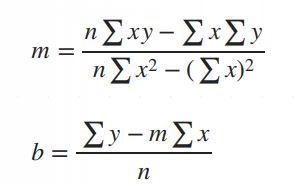
Simple Linear Regression in Data Science and machine learning
Simple linear regression is one of the most important techniques in data science and machine learning. It is the foundation of many statistical and machine learning models. Even though it is simple, its concepts are widely applicable in predicting outcomes and understanding relationships between variables.
This article will help you learn about:
1. What is simple linear regression and why it matters.
2. The step-by-step intuition behind it.
3. The math of finding slope() and intercept().
4. Simple linear regression coding using Python.
5. A practical real-world implementation.
If you are new to data science or machine learning, don’t worry! We will keep things simple so that you can follow along without any problems.
What is simple linear regression?
Simple linear regression is a method to model the relationship between two variables:
1. Independent variable (X): The input, also called the predictor or feature.
2. Dependent Variable (Y): The output or target value we want to predict.
The main purpose of simple linear regression is to find a straight line (called the regression line) that best fits the data. This line minimizes the error between the actual and predicted values.
The mathematical equation for the line is:
Y = mX + b
: The predicted values.
: The slope of the line (how steep it is).
: The intercept (the value of when).
Why use simple linear regression?
click here to read more https://datacienceatoz.blogspot.com/2025/01/simple-linear-regression-in-data.html
#artificial intelligence#bigdata#books#machine learning#machinelearning#programming#python#science#skills#big data#linear algebra#linear b#slope#interception
6 notes
·
View notes
Text
By: John Burn-Murdoch
Published: Mar 14, 2025
What is intelligence? This may sound like a straightforward question with a straightforward answer — the Oxford English Dictionary defines it as “a capacity to understand” — but that definition itself raises an increasingly relevant question in the modern world. What happens if the extent to which we can practically apply that capacity is diminishing? Evidence is mounting that something exactly like this has been happening to the human intellect over the past decade or so.
Nobody would argue that the fundamental biology of the human brain has changed in that far-too-short time span. However, across a range of tests, the average person’s ability to reason and solve novel problems appears to have peaked in the early 2010s and has been declining ever since.
When the latest round of analysis from PISA, the OECD’s international benchmarking test for performance by 15-year-olds in reading, mathematics and science tests, was released, the focus understandably fell on the role of the Covid pandemic in disrupting education. But this masked a longer-term and broader deterioration.

Longer-term in the sense that scores for all three subjects tended to peak around 2012. In many cases, they fell further between 2012 and 2018 than they did during the pandemic-affected years. And broader in that this decline in measures of reasoning and problem-solving is not confined to teenagers. Adults show a similar pattern, with declines visible across all age groups in last year’s update of the OECD’s flagship assessment of trends in adult skills.
Given its importance, there has been remarkably little consistent long-running research on human attention or mental capacity. But there is a rare exception: every year since the 1980s, the Monitoring the Future study has been asking 18-year-olds whether they have difficulty thinking, concentrating or learning new things. The share of final year high school students who report difficulties was stable throughout the 1990s and 2000s, but began a rapid upward climb in the mid-2010s.

This inflection point is noteworthy not only for being similar to performance on tests of intelligence and reasoning but because it coincides with another broader development: our changing relationship with information, available constantly online.
Part of what we’re looking at here is likely to be a result of the ongoing transition away from text and towards visual media — the shift towards a “post-literate” society spent obsessively on our screens.
The decline of reading is certainly real — in 2022 the share of Americans who reported reading a book in the past year fell below half.
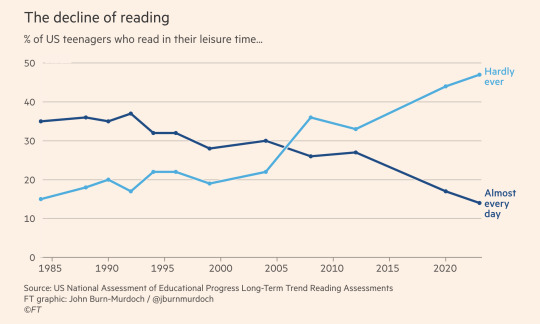
Particularly striking however is that we see this alongside decreasing performance in the application of numeracy and other forms of problem-solving in most countries.
In one particularly eye-opening statistic, the share of adults who are unable to “use mathematical reasoning when reviewing and evaluating the validity of statements” has climbed to 25 per cent on average in high-income countries, and 35 per cent in the US.

So we appear to be looking less at the decline of reading per se, and more at a broader erosion in human capacity for mental focus and application.
Most discussion about the societal impacts of digital media focuses on the rise of smartphones and social media. But the change in human capacity for focused thought coincides with something more fundamental: a shift in our relationship with information.
We have moved from finite web pages to infinite, constantly refreshed feeds and a constant barrage of notifications. We no longer spend as much time actively browsing the web and interacting with people we know but instead are presented with a torrent of content. This represents a move from self-directed behaviour to passive consumption and constant context-switching.
Research finds that active, intentional use of digital technologies is often benign or even beneficial. Whereas the behaviours that have taken off in recent years have been shown to affect everything from our ability to process verbal information, to attention, working memory and self-regulation.
The good news is that underlying human intellectual capacity is surely undimmed. But outcomes are a function of both potential and execution. For too many of us the digital environment is hampering the latter.
[ Archive: https://archive.today/vhoGi ]
#John Burn Murdoch#intelligence#literacy#numeracy#reading#math#comprehension#reading comprehension#social media#media consumption#social media content#religion is a mental illness
4 notes
·
View notes
Text
Top 7 AI Projects for High-Paying Jobs in 2025
7 AI Projects for High-Paying Jobs in 2025. Along the way, I��ve realized that the best candidates for AI and Data Science roles aren’t always the ones with top degrees or fancy universities. It’s the ones who show a genuine passion for the field through creative projects.
For example, one candidate built a personal stock prediction model to learn and shared it online—simple but impactful. These projects showed initiative and problem-solving skills, which hiring managers value more than technical expertise. I landed my first internship by showcasing similar projects.
In this article, I’ll share AI project ideas ideas for High-Paying Jobs that will help you stand out, along with tips and tools to get you started on your journey.
Table of Contents
1. Credit Report Analysis Using AI
Traditional credit scoring models often fail to assess those with thin credit histories, such as young people or immigrants. The dream project is to create an AI-based credit report analysis system leveraging alternative sources of existing data like the presence of social media (ethically and considering user consent), online transaction history, and even utility bill payments to provide a comprehensive perspective on an individual’s creditworthiness.
Example
Many companies in the financial sector use AI to speed up document processing and customer onboarding. Inscribe offers AI-powered document automation solutions that make the credit assessment process easier. Your project would involve:
Data Collection & Preprocessing: Gather data from diverse sources, ensuring privacy and security.
Feature Engineering: Identify meaningful features from non-traditional sources.
Model Building: Train models such as Random Forest or Gradient Boosting to predict creditworthiness.
Explainability: Use tools to explain predictions, ensuring transparency and fairness.
The frameworks and tools for this project would include Python, AWS S3, Streamlit, and machine learning techniques, offering a deep dive into the combination of AI and financial systems.
2. Summarization with Generative AI
In today’s information-overloaded world, summarization is a vital skill. This project demonstrates the power of Generative AI in creating concise, informative summaries of diverse content, whether it’s a document, a financial report, or even a complex story.
Consider a tool like CreditPulse, which utilizes large language models (LLMs) to summarize credit risk reports. Your project would involve fine-tuning pre-trained LLMs for specific summarization tasks. Here’s how to break it down:
Generative AI: Explore the key challenges in summarizing large, complex documents, and generate solutions using LLMs.
Training the Model: Fine-tune LLMs to better summarize financial reports or stories.
Synthetic Data Generation: Use generative AI to create synthetic data for training summarization models, especially if real-world data is limited.
By taking on this project, you demonstrate expertise in Natural Language Processing (NLP) and LLMs, which are essential skills for the AI-driven world.
3. Document Validation with Vision AI
Know Your Customer (KYC) processes are essential for fraud prevention and adherence to financial regulations. This is a Vision AI project that automates the document validation in the KYC process. Think of things like AI-powered Optical Character Recognition systems that scan and validate details from documents like your passport or driver’s license. This project would involve:
Data Preprocessing: Cleaning and organizing scanned document images.
Computer Vision Models: Train models to authenticate documents using OCR and image processing techniques.
Document Validation: Verify the authenticity of customer data based on visual and textual information.
This project demonstrates your expertise in computer vision, image processing, and handling unstructured data—skills that are highly valuable in real-world applications.
4. Text-to-SQL System with a Clarification Engine
Natural language interaction with the database is one of the most exciting areas of development in AI. This works on a text-to-SQl project that will show us how to make a text to an SQL query, with which we will be able to query a database just the way we query it. The Clarification Engine, which you’ll build to address ambiguity in user queries, will ask follow-up questions whenever a query is ambiguous. The project involves:
Dataset Creation: Build a dataset of natural language questions paired with SQL queries.
Model Training: Use sequence-to-sequence models to convert natural language into SQL.
Clarification Engine: Develop an AI system that asks follow-up questions to resolve ambiguity (e.g., “Which product?”, “What time frame?”).
Evaluation: Test the model’s accuracy and usability.
Incorporating tools like Google Vertex AI and PaLM 2, which are optimized for multilingual and reasoning tasks, can make this system even more powerful and versatile.
GitHub
5. Fine-tuning LLM for Synthetic Data Generation
In such situations where there is no or extremely limited access to real data due to sensitivity, AI data becomes indispensable. In this project, you will tune an LLM to generate synthetic-style datasets using the nature of a real dataset. This is a fascinating space, particularly since synthetic data can be used to train AI models in the absence of real-world data. Steps for this project include:
Dataset Analysis: Examine the dataset you want to mimic.
LLM Fine-tuning: Train an LLM on the real dataset to learn its patterns.
Synthetic Data Generation: Use the fine-tuned model to generate artificial data samples.
Evaluation: Test the utility of the synthetic data for AI model training.
This project showcases proficiency in LLMs and data augmentation techniques, both of which are becoming increasingly essential in AI and Data Science.
6. Personalized Recommendation System with LLM, RAG, Statistical model
Recommendation systems are everywhere—Netflix, Amazon, Spotify—but creating a truly effective one requires more than just user preferences. This project combines LLMs, Retrieval Augmented Generation (RAG), and traditional statistical models to deliver highly personalized recommendations. The project involves:
Data Collection: Gather user data and interaction history.
LLMs for Preference Understanding: Use LLMs to analyze user reviews, search history, or social media posts.
RAG for Context: Implement RAG to fetch relevant data from a knowledge base to refine recommendations.
Collaborative Filtering: Use statistical models to account for user interaction patterns.
Hybrid System: Combine the outputs of the models for accurate recommendations.
This project will showcase your ability to integrate diverse AI and data science techniques to build a sophisticated recommendation engine.
7. Self Host Llm Model Using Ollama, Vllm, How To Reduce Latency Of Inference
Hosting and deploying an LLM efficiently is an essential skill in AI. This project focuses on optimizing the deployment of an LLM using tools like Ollama or VLLM to reduce inference latency and improve performance. You’ll explore techniques like quantization, pruning, and caching to speed up model inference, making it more scalable. This project involves:
Model Deployment: Choose an open-source LLM and deploy it using Ollama/VLLM.
Optimization: Implement strategies like quantization to improve inference speed.
Performance Monitoring: Evaluate the model’s performance and adjust as needed.
Scalability: Use load balancing to manage multiple concurrent requests.
By completing this project, you’ll prove your expertise in LLM deployment, optimization, and building scalable AI infrastructure.
Conclusion
Break into a six-figure AI and Data Science career with these 7 projects. The goal is not to just get these projects done but to have the concepts in your head and the communication skills to explain your approach.
Consider documenting your projects on GitHub, and writing about your experiences in blog posts; not only does this help showcase your skills that you are interested in and willing to take the initiative.
Remember, in this rapidly evolving field, staying updated with the latest tools and techniques is crucial. Check out resources like NucleusBox for valuable insights and inspiration. The world of AI is vast and full of opportunities—so go ahead, dive in, and build something truly impactful!
2 notes
·
View notes
Text
Best Python Training in Marathahalli, Bangalore – Become a Python Expert & Launch a Future-Ready Career!
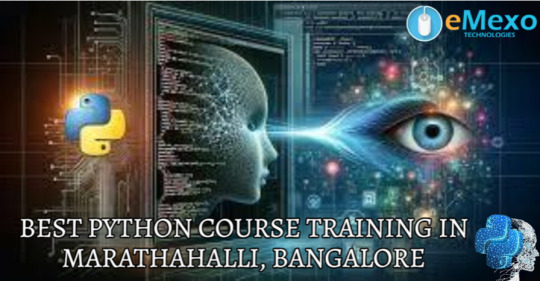
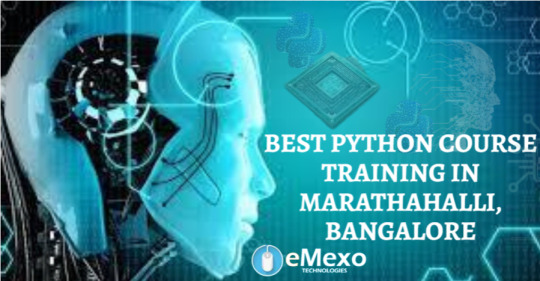




youtube
Want to master Python programming and build a successful IT career? Join eMexo Technologies for the Best Python Training in Marathahalli, Bangalore – your path to becoming a skilled Python developer with job-ready skills and industry certification.
Our Python Certification Course in Marathahalli, Bangalore is designed to equip you with in-demand programming skills, whether you're a beginner or an experienced professional. With real-time projects, hands-on exercises, and expert mentorship, you’ll gain the confidence to build real-world applications and secure your dream job.
🌟 Who Should Join Our Python Course in Marathahalli, Bangalore?
This Python Course in Marathahalli, Bangalore is ideal for:
Students and freshers looking to start their programming career
Software developers and IT professionals upskilling in Python
Data analysts and automation testers using Python for scripting
Anyone looking to crack technical interviews or get Python certified
📘 What You’ll Learn in Our Python Certification Course Marathahalli, Bangalore:
Core Python Programming: Variables, data types, loops, functions, OOP concepts
Advanced Python Concepts: File handling, exception handling, modules, decorators
Web Development with Python: Introduction to Django/Flask frameworks
Database Integration: Using Python with MySQL and SQLite
Automation & Scripting: Build scripts for real-time problem-solving
Live Projects: Real-world applications like calculators, dashboards, and web apps
🚀 Why Choose eMexo Technologies for Python Training in Marathahalli, Bangalore?
We are more than just a Python Training Center in Marathahalli, Bangalore – we are your learning partner. Our focus is on providing career-oriented Python training through certified instructors, hands-on practice, and real-time case studies.
What Makes Us the Best Python Training Institute in Marathahalli, Bangalore:
✅ Industry-expert trainers with real-world Python experience ✅ Fully-equipped classrooms and interactive online sessions ✅ 100% practical-oriented training with live project support ✅ Personalized career guidance, resume building & mock interviews ✅ Dedicated Python training placement in Marathahalli, Bangalore
📅 Upcoming Python Training Batch Details:
Start Date: July 1st, 2025
Time: 10:00 AM IST
Location: eMexo Technologies, Marathahalli, Bangalore
Mode: Both Classroom & Online Training Available
👥 Who Can Benefit from This Python Training Marathahalli, Bangalore?
Students & fresh graduates planning to enter the IT sector
Working professionals aiming to switch to Python development
Testers, analysts, and engineers looking to automate workflows
Anyone passionate about coding and application development
🎯 Get Certified. Get Placed. Get Ahead.
Join the top-rated Python Training Institute in Marathahalli, Bangalore and open doors to careers in software development, automation, web development, and data science.
📞 Call or WhatsApp: +91-9513216462 📧 Email: [email protected] 🌐 Website: https://www.emexotechnologies.com/courses/python-training-in-marathahalli-bangalore/
🚀 Limited Seats Available – Enroll Today and Start Your Python Journey!
🔖 Hashtags:
#PythonTrainingInMarathahalliBangalore#PythonCertificationCourseInMarathahalliBangalore#PythonCourseInMarathahalliBangalore#PythonTrainingCenterInMarathahalliBangalore#PythonTrainingInstituteInMarathahalliBangalore#eMexoTechnologies#PythonProjects#PythonTrainingPlacementInMarathahalliBangalore#ITTrainingBangalore#PythonJobs#BestPythonTrainingInstituteInMarathahalliBangalore#LearnPython#PythonProgramming#PythonForBeginners#Youtube
2 notes
·
View notes
Text
Best Python Training in Marathahalli, Bangalore – Become a Python Expert & Launch a Future-Ready Career!
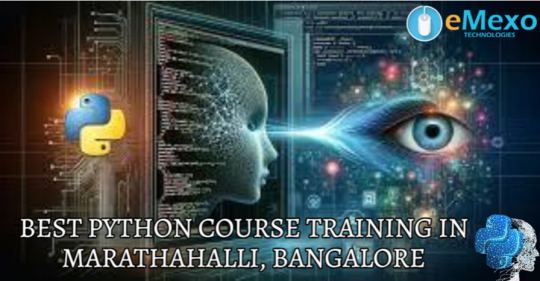
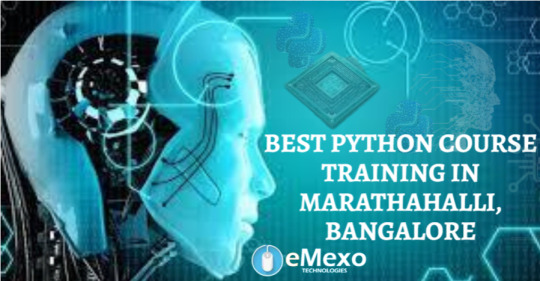




youtube
Want to master Python programming and build a successful IT career? Join eMexo Technologies for the Best Python Training in Marathahalli, Bangalore – your path to becoming a skilled Python developer with job-ready skills and industry certification.
Our Python Certification Course in Marathahalli, Bangalore is designed to equip you with in-demand programming skills, whether you're a beginner or an experienced professional. With real-time projects, hands-on exercises, and expert mentorship, you’ll gain the confidence to build real-world applications and secure your dream job.
🌟 Who Should Join Our Python Course in Marathahalli, Bangalore?
This Python Course in Marathahalli, Bangalore is ideal for:
Students and freshers looking to start their programming career
Software developers and IT professionals upskilling in Python
Data analysts and automation testers using Python for scripting
Anyone looking to crack technical interviews or get Python certified
📘 What You’ll Learn in Our Python Certification Course Marathahalli, Bangalore:
Core Python Programming: Variables, data types, loops, functions, OOP concepts
Advanced Python Concepts: File handling, exception handling, modules, decorators
Web Development with Python: Introduction to Django/Flask frameworks
Database Integration: Using Python with MySQL and SQLite
Automation & Scripting: Build scripts for real-time problem-solving
Live Projects: Real-world applications like calculators, dashboards, and web apps
🚀 Why Choose eMexo Technologies for Python Training in Marathahalli, Bangalore?
We are more than just a Python Training Center in Marathahalli, Bangalore – we are your learning partner. Our focus is on providing career-oriented Python training through certified instructors, hands-on practice, and real-time case studies.
What Makes Us the Best Python Training Institute in Marathahalli, Bangalore:
✅ Industry-expert trainers with real-world Python experience ✅ Fully-equipped classrooms and interactive online sessions ✅ 100% practical-oriented training with live project support ✅ Personalized career guidance, resume building & mock interviews ✅ Dedicated Python training placement in Marathahalli, Bangalore
📅 Upcoming Python Training Batch Details:
Start Date: July 1st, 2025
Time: 10:00 AM IST
Location: eMexo Technologies, Marathahalli, Bangalore
Mode: Both Classroom & Online Training Available
👥 Who Can Benefit from This Python Training Marathahalli, Bangalore?
Students & fresh graduates planning to enter the IT sector
Working professionals aiming to switch to Python development
Testers, analysts, and engineers looking to automate workflows
Anyone passionate about coding and application development
🎯 Get Certified. Get Placed. Get Ahead.
Join the top-rated Python Training Institute in Marathahalli, Bangalore and open doors to careers in software development, automation, web development, and data science.
📞 Call or WhatsApp: +91-9513216462 📧 Email: [email protected] 🌐 Website: https://www.emexotechnologies.com/courses/python-training-in-marathahalli-bangalore/
🚀 Limited Seats Available – Enroll Today and Start Your Python Journey!
🔖 Hashtags:
#PythonTrainingInMarathahalliBangalore#PythonCertificationCourseInMarathahalliBangalore#PythonCourseInMarathahalliBangalore#PythonTrainingCenterInMarathahalliBangalore#PythonTrainingInstituteInMarathahalliBangalore#eMexoTechnologies#PythonProjects#PythonTrainingPlacementInMarathahalliBangalore#ITTrainingBangalore#PythonJobs#BestPythonTrainingInstituteInMarathahalliBangalore#LearnPython#PythonProgramming#PythonForBeginners#Youtube
2 notes
·
View notes
Text
How is AI transforming the recruitment process in 2025?

Picture this: You're sipping your morning coffee, scrolling through job applications, and within minutes, you've identified the top 10 candidates from a pool of 500 resumes. Sounds like magic?
Welcome to 2025, where artificial intelligence has turned this fantasy into everyday reality for recruiters worldwide. The hiring landscape has shifted dramatically, and if you're still manually sorting through CVs, you might as well be using a typewriter in the smartphone era.
The Smart Screening Revolution
Gone are the days when HR teams spent countless hours reading through every single resume. Modern AI resume screening software has become the ultimate hiring assistant, analyzing candidate profiles with superhuman speed and accuracy.
These intelligent systems can evaluate skills, experience, and cultural fit within seconds, transforming what used to be a week-long process into a matter of hours.
The technology doesn't just scan for keywords anymore. Today's advanced algorithms understand context, recognize transferable skills, and even assess personality traits through language patterns.
It's like having a seasoned recruiter with photographic memory working 24/7.
Beyond the Buzzwords: Real Impact
The transformation goes deeper than just faster screening. AI is fundamentally changing how companies approach talent acquisition.
Predictive analytics now help organizations forecast which candidates are most likely to succeed in specific roles, reducing turnover rates by up to 40%.
Video interview analysis has evolved too. AI systems can now evaluate communication skills, confidence levels, and even detect potential red flags through facial expressions and speech patterns. While this might sound like science fiction, it's happening right now in major corporations across the globe.
The Bias-Busting Game Changer
One of the most significant advantages of AI in recruitment is its potential to reduce unconscious bias. Traditional hiring often falls victim to human prejudices based on names, photos, or educational backgrounds.
Smart recruitment tools focus purely on skills and qualifications, creating a more level playing field for all candidates.
However, it's worth noting that AI systems are only as unbiased as the data they're trained on.
Forward-thinking companies are actively working to ensure their algorithms promote diversity rather than perpetuate existing inequalities.
The Numbers Game: Efficiency Meets Precision
The statistics speak volumes about AI's impact on modern recruitment. Companies using intelligent hiring solutions report 50% faster time-to-hire and 60% improvement in candidate quality.
The applicant tracking system has evolved from a simple database to a sophisticated decision-making partner.
Natural language processing (NLP) has revolutionized how these systems understand resumes and job descriptions.
Instead of rigid keyword matching, modern platforms can interpret meaning, context, and even industry-specific jargon.
This advancement means better matches between candidates and positions.
The Human Touch in an AI World
Despite all this technological advancement, the human element remains irreplaceable.
AI handles the heavy lifting of initial screening and data analysis, but final hiring decisions still require human judgment, emotional intelligence, and cultural assessment.
The most successful companies in 2025 are those that have found the perfect balance between AI efficiency and human insight.
They use technology to eliminate tedious tasks while preserving the personal connection that makes great hiring decisions.
Looking Ahead: What's Next?
As we move further into 2025, expect to see even more sophisticated AI features. Real-time skills assessment, virtual reality job simulations, and AI-powered salary negotiations are already being tested by innovative companies.
Platforms like Scan2hire are leading this transformation, offering comprehensive solutions that streamline the entire recruitment process.
From initial resume parsing to final candidate ranking, these tools are setting new standards for what's possible in talent acquisition.
The future belongs to organizations that embrace these technological advances while maintaining their commitment to fair, human-centered hiring practices.
Those who adapt quickly will gain a significant competitive advantage in attracting top talent.
The Bottom Line
AI isn't just changing recruitment—it's revolutionizing it completely. Companies that leverage these tools effectively are finding better candidates faster, reducing costs, and creating more positive experiences for everyone involved in the hiring process.
The question isn't whether AI will transform recruitment, but how quickly your organization will adapt to this new reality.
The future of hiring is here, powered by Scan2hire and similar innovative solutions, and it's more exciting than ever.
2 notes
·
View notes
Text
Top B.Tech Courses in Maharashtra – CSE, AI, IT, and ECE Compared
B.Tech courses continue to attract students across India, and Maharashtra remains one of the most preferred states for higher technical education. From metro cities to emerging academic hubs like Solapur, students get access to diverse courses and skilled faculty. Among all available options, four major branches stand out: Computer Science and Engineering (CSE), Artificial Intelligence (AI), Information Technology (IT), and Electronics and Communication Engineering (ECE).
Each of these streams offers a different learning path. B.Tech in Computer Science and Engineering focuses on coding, algorithms, and system design. Students learn Python, Java, data structures, software engineering, and database systems. These skills are relevant for software companies, startups, and IT consulting.
B.Tech in Artificial Intelligence covers deep learning, neural networks, data processing, and computer vision. Students work on real-world problems using AI models. They also learn about ethical AI practices and automation systems. Companies hiring AI talent are in healthcare, retail, fintech, and manufacturing.
B.Tech in IT trains students in systems administration, networking, cloud computing, and application services. Graduates often work in system support, IT infrastructure, and data management. IT blends technical and management skills for enterprise use.
B.Tech ECE is for students who enjoy working with circuits, embedded systems, mobile communication, robotics, and signal processing. This stream is useful for telecom companies, consumer electronics, and control systems in industries.
Key Differences Between These B.Tech Programs:
CSE is programming-intensive. IT includes applications and system-level operations.
AI goes deeper into data modeling and pattern recognition.
ECE focuses more on hardware, communication, and embedded tech.
AI and CSE overlap, but AI involves more research-based learning.
How to Choose the Right B.Tech Specialization:
Ask yourself what excites you: coding, logic, data, devices, or systems.
Look for colleges with labs, project-based learning, and internship support.
Talk to seniors or alumni to understand real-life learning and placements.
Explore industry demand and long-term growth in each field.
MIT Vishwaprayag University, Solapur, offers all four B.Tech programs with updated syllabi, modern infrastructure, and practical training. Students work on live projects, participate in competitions, and build career skills through soft skills training. The university also encourages innovation and startup thinking.
Choosing the right course depends on interest and learning style. CSE and AI suit tech lovers who like coding and research. ECE is great for those who enjoy building real-world devices. IT fits students who want to blend business with technology.
Take time to explore the subjects and talk to faculty before selecting a stream. Your B.Tech journey shapes your future, so make an informed choice.
#B.Tech in Computer Science and Engineering#B.Tech in Artificial Intelligence#B.Tech in IT#B.Tech ECE#B.Tech Specialization
2 notes
·
View notes
Text
Is AT8XM Robot Legit Or Not? - AT8XM Robot PayPal Review

Explore the AT8XM Robot Paypal Review to uncover how this AI-driven forex trading system operates, its PayPal integration, and why it could be a game-changer for both new and seasoned traders.
The AT8XM Robot Paypal system combines artificial intelligence with PayPal integration to simplify forex trading. Learn how it works, who it’s for, and what makes it an appealing choice for automated traders.
Introduction
Let’s face it—forex trading can be a tricky beast. With markets shifting in the blink of an eye and economic news constantly rolling in, it’s tough to stay ahead of the curve. That’s where the AT8XM Robot Paypal steps into the spotlight. This AI-powered forex trading tool doesn’t just promise ease of use and smart trading; it also connects with PayPal, making transactions smooth as silk.
So, whether you're green around the gills or a trading veteran, this review will walk you through what makes the AT8XM Robot Paypal stand out in the world of automated forex systems.
What Is AT8XM Robot Paypal?
The AT8XM Robot Paypal is an automated forex trading application that leverages AI to scan markets, spot trading opportunities, and execute trades without needing constant human input. As if that wasn’t enough, it’s designed to be compatible with PayPal, adding a trusted layer of convenience for users handling deposits and withdrawals.
Top Features at a Glance
Smart AI Trading Engine
24/7 Market Monitoring
PayPal Payment Integration
User-Friendly Dashboard
Beginner-Friendly Setup
Real-Time Data Analysis
Customizable Risk Settings
This robot doesn’t sleep, doesn’t hesitate, and doesn’t complain—it just keeps scanning the forex market, aiming for profitable trades while the user can sit back and relax.
How AT8XM Robot Paypal Works
It might sound like rocket science, but the logic behind the AT8XM Robot Paypal is fairly straightforward:
Setup & Connect Broker – Users first create an account and connect it with a recommended broker.
Link PayPal – Funds can be deposited or withdrawn using PayPal, adding a layer of convenience.
Activate Robot – Once active, the robot starts scanning market conditions in real-time.
Trade Execution – Based on algorithmic decisions, it places trades aimed at maximizing profit.
Profit Monitoring – All gains go straight into the broker account, accessible via PayPal.
Pretty neat, huh? With minimal effort, users get a full-fledged trading partner running in the background.
Why Traders Are Buzzing About AT8XM Robot Paypal
There’s no shortage of reasons why this trading tool is gaining popularity:
Saves Time – No need to analyze charts all day.
Emotion-Free Trading – Decisions are driven by data, not by human impulse.
Trusted Payments – PayPal support adds an extra layer of user trust.
Ease of Use – Setup takes minutes, not hours.
Flexible Trading Options – Users can set their own trading limits and preferences.
Low Barrier to Entry – No prior trading knowledge required.
Who Stands to Benefit from AT8XM Robot Paypal?
The short answer? Just about anyone looking to dip their toes into the forex market or take their trading to the next level.
Complete Beginners – It’s plug-and-play simplicity helps new traders ease in.
Busy Professionals – They can let the bot do the legwork while they focus on other things.
Cautious Investors – The customizable risk settings are ideal for those who like to play it safe.
Experienced Traders – Automation lets them scale their strategies without burning out...
Is AT8XM Robot Legit Or Not? Full AT8XM Robot PayPal Review here! at https://scamorno.com/Robot-AT8XM-Review-App/?id=tumblr-legitornotpaypal
Security & Reliability: Is It the Real Deal?
Ah, the million-dollar question. The AT8XM Robot Paypal is reportedly backed by strong encryption and secure broker partnerships. And when PayPal’s in the mix, users often feel a bit more at ease, knowing that their transactions are protected by one of the most trusted online payment platforms out there.
Still, no system is perfect. As always, users should stick with well-reviewed brokers and do a touch of homework before diving in headfirst.
FAQs About AT8XM Robot Paypal
1. Is AT8XM Robot Paypal compatible with any broker?
Not quite. It usually works best with specific recommended brokers that support its integration and features.
2. Do I need trading experience to use it?
Nope! The platform is beginner-friendly, offering automated decisions without requiring deep knowledge of the forex market.
3. How does PayPal come into play?
Users can link their PayPal accounts for depositing and withdrawing funds, which adds a safe and well-known payment method into the mix.
4. Are the profits guaranteed?
Well, let’s not count chickens before they hatch. Like all trading, there’s risk involved. However, the robot is designed to increase the odds in the user’s favor.
5. Can I adjust the robot’s settings?
Absolutely! Users can customize risk levels, stop-loss limits, and trade sizes according to their comfort level...
Is AT8XM Robot Legit Or Not? Full AT8XM Robot PayPal Review here! at https://scamorno.com/Robot-AT8XM-Review-App/?id=tumblr-legitornotpaypal
2 notes
·
View notes
Text
Optimizing Insurance with Data Science Insights - Dataforce

Key Highlights
Data science is transforming the insurance industry through advanced analytics and AI integration.
Enhancing fraud detection and improving risk assessment are vital applications of data science in insurance.
Personalizing customer experiences and boosting engagement with data-driven strategies are key focus areas.
Overcoming challenges like data privacy concerns and talent gap is crucial for successful data science implementation in insurance.
Future trends in insurance data science include the rise of AI and machine learning in policy customization and leveraging big data for market analysis.
Introduction
The insurance industry, including auto insurance, is entering a new age of data in the insurance domain. Data science, driven by artificial intelligence (AI), is changing how insurance companies operate. This change is making the industry more focused on data, leading to better risk assessments, customized customer experiences, and an increased risk in smoother operations. This blog looks at how data science is changing the insurance world and what it could mean for the future.
The Evolution of Data Science in the Insurance Sector
The insurance sector has always worked with data. But, in the past, they only focused on simple numbers and past trends in life insurance. Now, with data science, they can look at big and complex data much better. This change helps insurance companies to go beyond old methods and enhance their product offerings through various use cases. They can now use better models to check risks, spot fraud, and know what customers need.
Bridging the Gap: Data Professionals and Insurance Innovations
Insurance companies are now bringing together data science and real-life use through predictive analysis, particularly in the realm of insurance data analytics. They do this by hiring data experts who know about both insurance and data analytics. These experts can use data analytics to tackle tough business issues, including finding new market chances and relevant products, better pricing plans, and improving risk management. They use business intelligence to help make smart decisions and improve how insurance works.
Transforming Insurance Through Data Analytics and AI Integration
The use of AI, especially machine learning, is changing how insurance works in important ways:
Automated Underwriting: AI can look at a lot of data to see risk levels. It helps make underwriting decisions quickly and efficiently.
Fraud Detection: Machine learning helps find fake claims by spotting patterns and odd things that people might miss.
Predictive Modeling: With data science, insurers can predict future events. This includes things like customer drop-off or how likely claims are to happen.
This use of AI is not to replace human skills. Instead, it supports insurance experts, helping them make smarter decisions.

Key Areas Where Data Science is Revolutionizing Insurance
Let’s look at how data science is changing the insurance field. Data science is improving how insurance companies work and opening up new opportunities. It helps in better fraud detection and makes customer interactions more personal. Overall, data science is changing how insurance companies operate and connect with their policyholders.
Enhancing Fraud Detection with Advanced Data Models
Insurance fraud is a big problem. It costs a lot for insurers and their customers. Data science can help to fight fraud by using smart data models. These can find patterns that show fraudulent activities:
Anomaly Detection: Data analysis can spot strange patterns in insurance claims. For example, a sudden rise in claims or higher amounts could suggest fraud.
Network Analysis: By looking at links between policyholders, providers, and others, insurers can find fraud networks or are working together.
Predictive Modeling: Data-driven models can help insurers figure out how likely a claim is to be fraudulent. This helps them focus their investigations better.
Improving Risk Assessment through Predictive Analytics
Data science changes how we assess risks using predictive analytics. These tools help insurers better estimate the chance of future events, like accidents, illnesses, or natural disasters.
Personalized Risk Profiles: Insurers now create risk profiles for each person. They look at personal behavior, lifestyle choices, and where someone lives, instead of just using general demographic data.
Dynamic Pricing: Predictive models help insurers change insurance costs quickly. They adjust premiums based on factors that change, like driving habits tracked through telematics or health information from wearables.
Proactive Risk Management: Insurers can spot risks before they happen. This way, they can help customers reduce risks, stop potential losses, and improve safety overall.

Data Science’s Role in Personalizing Customer Experiences
In today’s tough market, insurance companies need to give a personalized customer experience. Customers now expect services and products made just for them. Data science plays a key role in helping insurance companies understand what each customer wants and needs.
Tailoring Insurance Products with Customer Data Insights
Data science helps insurance companies provide better products to their customers. They can now focus on making insurance products that fit specific groups of people instead of just offering the same products to everyone.
Customer Segmentation: By looking at customer data, insurers can divide their customers into different groups. These groups are based on similar traits, like risk levels, lifestyle choices, or financial goals.
Personalized Product Recommendations: Insurers can use data to suggest the best insurance products for each customer based on their unique profile.
Customized Policy Features: Insights from data allow insurance companies to create flexible policy options that meet the needs of individual customers.
Boosting Customer Engagement with Data-Driven Strategies
Data science helps insurance companies improve how they engage with customers and build better relationships. Here are some ways they do this:
Proactive Communication: Insurers can look at customer data to understand what customers might need. This way, they can reach out to them with helpful info, advice, or special offers.
Personalized Customer Support: With data insights, insurance companies can change their support to fit each person’s needs and past experiences. This helps make customers happier.
Targeted Marketing Campaigns: Data-driven marketing lets companies send messages and offers that are more relevant to different groups of customers, making their campaigns more effective.
These methods not only boost customer satisfaction but also give insurance companies a competitive edge.
Overcoming Challenges in Data Science Application in Insurance
The potential of data science in the insurance business is huge. However, companies face challenges that they must tackle to enjoy these benefits fully. Data security and privacy are key worries. There is also a need for trained data scientists who know the insurance industry well.
Navigating Data Privacy and Security Concerns
As insurance companies gather and study more personal data, it is very important to deal with privacy and security issues.
Data Security Measures: It is key to have strong security measures in place to keep customer information safe from unauthorized access and cyber threats.
Compliance with Regulations: Insurance companies need to follow laws about data protection, like GDPR or CCPA, to ensure they handle data responsibly.
Transparency and Trust: Being open with customers about how their data is collected, used, and protected is vital. This builds trust and supports good data practices.
Addressing the Talent Gap in Data Science for Insurance
There is a bigger demand for data scientists who know a lot about the insurance sector. Filling this gap is important for companies that want to use data science well.
Attracting and Keeping Talent: To draw in and keep the best data science talent, companies need to offer good pay and chances for growth.
Training the Current Team: Insurance companies can put money into training programs to help their workers gain the skills they need for a data-focused job.
Working Together: Teaming up with universities or training groups can help solve the skills gap and open doors to more qualified job candidates.
Future Trends: The Next Frontier in Insurance Data Science
Data science is changing and will bring new and exciting uses in the insurance field. The ongoing progress of AI, along with very large sets of data, will change the industry even more.
The Rise of AI and Machine Learning in Policy Customization
AI and machine learning are expected to play an even greater role in personalizing insurance policies:
AI-Powered Policy Customization: AI algorithms can create highly customized insurance policies that consider individual risk factors, lifestyle choices, and even behavioral data.
Real-Time Policy Adjustments: AI can facilitate real-time adjustments to insurance policies based on changing customer needs or risk profiles.
Predictive Risk Prevention: AI-powered systems can proactively identify and mitigate potential risks by analyzing data from various sources, including IoT devices and wearables.
Future Trend
Description
AI-Driven Chatbots
Provide 24/7 customer support, answer policy questions, and assist with claims filing.
Blockchain for Claims Processing
Enhance the security and transparency of claims processing by creating tamper-proof records.
Drone Technology in Risk Assessment
Used to assess property damage, particularly in remote or hard-to-reach areas.
Leveraging Big Data for Comprehensive Market Analysis
Insurance companies are using big data analytics more and more. This helps them understand market trends, customer behavior, and what their competitors are doing.
Competitive Analysis: Big data analytics help insurers track their competitors. This includes what products they offer and how they price them. This way, insurers can spot chances in the market.
Market Trend Prediction: By looking at large amounts of data, insurers can guess future market trends. This might be about new risks, what customers want, or changes in rules. With this knowledge, they can change their plans early.
New Product Development: Insights from big data can help create new insurance products. These products meet changing customer needs and include options like usage-based insurance, micro-insurance, and on-demand insurance.
Conclusion
In conclusion, data science is changing the insurance industry. It helps find fraud, improves how risks are assessed, and makes customer experiences better. With AI and machine learning, companies can create more personalized policies and do better market analysis. There are some challenges, like keeping data private and not having enough skilled workers. Still, the future of insurance will rely on using big data insights. By accepting data science ideas, the insurance sector will become more efficient and focused on the customer. It is important to stay updated, adjust to new technologies, and see how data science can transform how insurance is done.
2 notes
·
View notes
Text
Best AI Training in Electronic City, Bangalore – Become an AI Expert & Launch a Future-Proof Career!



youtube
Artificial Intelligence (AI) is reshaping industries and driving the future of technology. Whether it's automating tasks, building intelligent systems, or analyzing big data, AI has become a key career path for tech professionals. At eMexo Technologies, we offer a job-oriented AI Certification Course in Electronic City, Bangalore tailored for both beginners and professionals aiming to break into or advance within the AI field.
Our training program provides everything you need to succeed—core knowledge, hands-on experience, and career-focused guidance—making us a top choice for AI Training in Electronic City, Bangalore.
🌟 Who Should Join This AI Course in Electronic City, Bangalore?
This AI Course in Electronic City, Bangalore is ideal for:
Students and Freshers seeking to launch a career in Artificial Intelligence
Software Developers and IT Professionals aiming to upskill in AI and Machine Learning
Data Analysts, System Engineers, and tech enthusiasts moving into the AI domain
Professionals preparing for certifications or transitioning to AI-driven job roles
With a well-rounded curriculum and expert mentorship, our course serves learners across various backgrounds and experience levels.
📘 What You Will Learn in the AI Certification Course
Our AI Certification Course in Electronic City, Bangalore covers the most in-demand tools and techniques. Key topics include:
Foundations of AI: Core AI principles, machine learning, deep learning, and neural networks
Python for AI: Practical Python programming tailored to AI applications
Machine Learning Models: Learn supervised, unsupervised, and reinforcement learning techniques
Deep Learning Tools: Master TensorFlow, Keras, OpenCV, and other industry-used libraries
Natural Language Processing (NLP): Build projects like chatbots, sentiment analysis tools, and text processors
Live Projects: Apply knowledge to real-world problems such as image recognition and recommendation engines
All sessions are conducted by certified professionals with real-world experience in AI and Machine Learning.
🚀 Why Choose eMexo Technologies – The Best AI Training Institute in Electronic City, Bangalore
eMexo Technologies is not just another AI Training Center in Electronic City, Bangalore—we are your AI career partner. Here's what sets us apart as the Best AI Training Institute in Electronic City, Bangalore:
✅ Certified Trainers with extensive industry experience ✅ Fully Equipped Labs and hands-on real-time training ✅ Custom Learning Paths to suit your individual career goals ✅ Career Services like resume preparation and mock interviews ✅ AI Training Placement in Electronic City, Bangalore with 100% placement support ✅ Flexible Learning Modes including both classroom and online options
We focus on real skills that employers look for, ensuring you're not just trained—but job-ready.
🎯 Secure Your Future with the Leading AI Training Institute in Electronic City, Bangalore
The demand for skilled AI professionals is growing rapidly. By enrolling in our AI Certification Course in Electronic City, Bangalore, you gain the tools, confidence, and guidance needed to thrive in this cutting-edge field. From foundational concepts to advanced applications, our program prepares you for high-demand roles in AI, Machine Learning, and Data Science.
At eMexo Technologies, our mission is to help you succeed—not just in training but in your career.
📞 Call or WhatsApp: +91-9513216462 📧 Email: [email protected] 🌐 Website: https://www.emexotechnologies.com/courses/artificial-intelligence-certification-training-course/
Seats are limited – Enroll now in the most trusted AI Training Institute in Electronic City, Bangalore and take the first step toward a successful AI career.
🔖 Popular Hashtags
#AITrainingInElectronicCityBangalore#AICertificationCourseInElectronicCityBangalore#AICourseInElectronicCityBangalore#AITrainingCenterInElectronicCityBangalore#AITrainingInstituteInElectronicCityBangalore#BestAITrainingInstituteInElectronicCityBangalore#AITrainingPlacementInElectronicCityBangalore#MachineLearning#DeepLearning#AIWithPython#AIProjects#ArtificialIntelligenceTraining#eMexoTechnologies#FutureTechSkills#ITTrainingBangalore#Youtube
3 notes
·
View notes